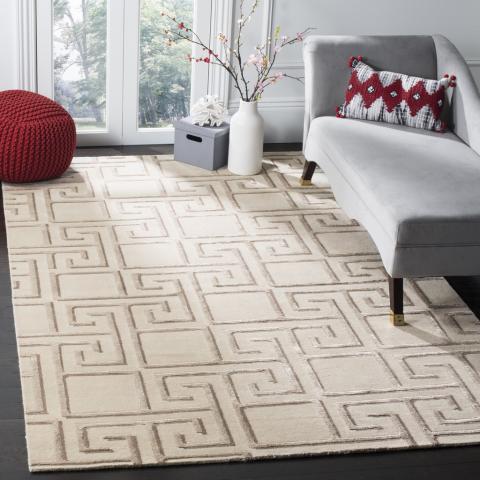Area Rug Construction
| Before the rug can be woven, the weavers must refer to a full-scale graph paper drawing of the rug, called the cartoon. This is basically a chart in which each tiny square represents one knot. The design is drawn and colored so the weavers know when to change yarns. Next the loom must be strung. The warp is tied vertically to the loom, and then the weft is woven through it in a basket weave fashion. This is considered the foundation of the rug; and it is made from cotton, wool, or silk. In between the layers of weft threads, the weavers tie knots onto the warp in a horizontal row, which creates the pile. Most weavers tie an average of 5000 to 6000 knots per day. Generally speaking, the finer the weave (smaller the knot), the more detailed the design may be. Handmade rugs are often judged in part by the knots per square inch. A coarse weave is typically less than 40 knots, medium is between 40-90, fine is between 90-180, and very fine is 180 and up. Most importantly, the weave should fit the design. The finished rug needs to have good clarity in the design, so it doesn't look fuzzy or blocky. A fine weave becomes more important if you want a very detailed pattern, and less important if you desire a simplistic design. Contrary to popular belief, the average rug weaver is a 25 year old male who comes from a family that has probably been weaving rugs for many generations. Once the rug has been woven to its finished size it is cut off the loom and goes through a series of steps in order to be completed. The ends are usually finished by weaving the weft threads through the warp to create the selvage. This is a tight flat-weaving process often used to protect the knots; as well as to add a decorative or finished look. The remains of the warp strands actually become the fringe. Then the sides of the rug are overcast in the same material the rug is woven in. Next the carpet is hand sheared, washed, and is then ready for inspection. This completes a typical hand knotted rug weaving process. |
|
Machine Made Rugs: Machine made rugs are woven on power looms operated either by hand, machine, or computer. The design and colors are determined, and a computer card is created which tells the computer which size and color it needs to produce. The loom is strung with a warp of jute, or sometimes cotton. The rug is then woven using wool, nylon, polypropylene, olefin, or any other yarn suitable. Wool is the most durable and easiest to clean, as well as the most expensive. Some of the common synthetic materials are olefin, which is resilient and if heat set, is not as shiny as many others; polypropylene, which tends to flatten more readily; and nylon which is generally less durable. All of the synthetics do not clean as well as wool, but can be more cost effective. There are two types of looms used to create three different categories of oriental reproductions: Wilton, Cross-woven Wilton, and Axminster. Each of these can be designed to achieve different pile heights and density, as well as various finishes and qualities. |
|
Hand-Hooked: In creating a hooked rug a canvas cloth is first attached to a frame. Using a hooking device and following the pattern, the weaver punches the yarn up through the canvas, creating a looped pile. For better surface coverage the design is worked in a crescent pattern instead of straight rows, which tend to separate easier. Next the rug is taken off the frame and a layer of latex glue is spread over the back of the rug. This is necessary to hold the yarns in place, as they have not been knotted or tied into the foundation. It is important to note that the long ends of wool that often appear on the surface of the hooked rug (called sprouts) must not be pulled for this very reason. If they are pulled, versus cutting them even with the pile, it will result in a section of missing wool and will damage the rug. After applying the glue, a cloth is attached to further protect the back of the rug. Lastly, the edges of the canvas are turned under and stitched. The quality and durability of hooked rugs vary, but it is mostly based on the point (stitch) size; the smaller the loop the better. Gross Point is the largest loop size and is used for larger scale designs. Petit Point is a smaller loop and allows for a more detailed design. Micro hooked is the finest weave, and gives both the most detail and the best durability in hooked rugs. As is true with all rugs, the quality of the wool is equally important. |
|
Hand-Tufted: Hand tufted rugs are created in a very similar fashion to hand hooked rugs. The major difference is that after the loop pile is created, it is usually sheared to produce a flat pile surface. The weaver also uses a lot more wool and a heavier canvas backing in constructing this style rug; for a rugged, more durable carpet. Fringe is often sewn on once the rug is completed. |
|
Flat weaves: This category includes Dhurries, Kelims, and Soumaks; among other types. They are all pile less, reversible rugs, which are created when a weft is woven across a warp in a basket weave fashion, making a design. The weft is usually wool and the warp is either cotton or wool. These flat woven carpets, like their handmade counterparts, are created with natural or chrome dyes. The quality is again determined by the amount of labor involved, i.e. the intricacy of the weave; and the quality of the materials. |
|
Braided: The first braided rugs were created by Early American settlers using old pieces of blankets, clothing, canvas, and other materials. There are several different types of braids. Flat braids are braided around two guide yarns, which makes them more durable. Tubular braids contain a single core, around which the surface yarns are knitted. Tape braids use three solid pieces of material braided in a traditional fashion. Yarn braids consist of several three-ply yarns which make up one part of the three elements of a braid. Braided rugs are woven with many different materials ranging from nylon, to cotton chenille, to wool, and even blends of different materials. The quality is again determined by the tightness of the braid and the materials used. |

